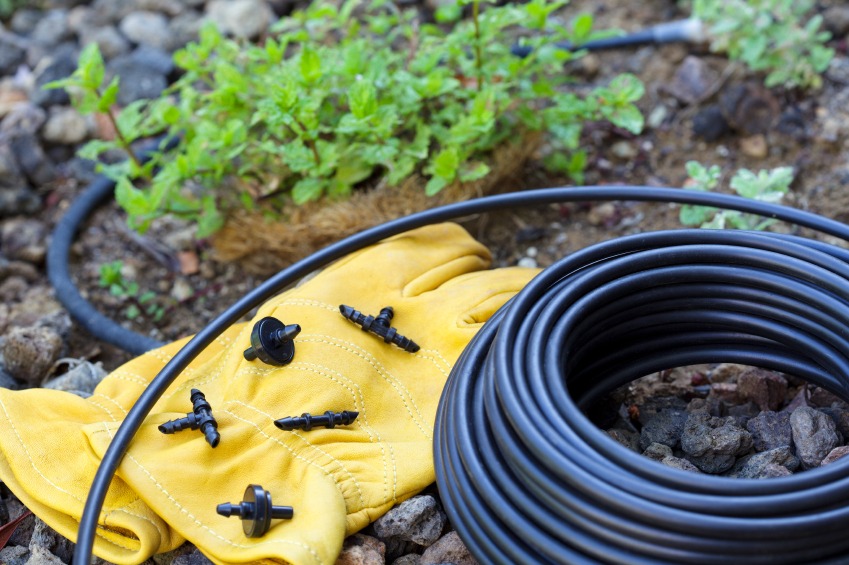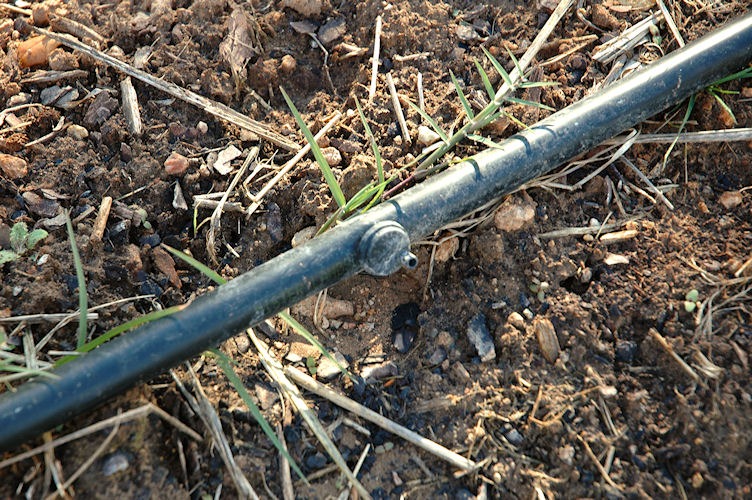How To Repair Hole In Irrigation Hose
Repair Drip Irrigation Guide: How To Fix It Yourself Without Your Gardener

Baste irrigation is a very common water-wise method of watering plants in Southern California. Almost homeowners inherit drip systems with their homes or take them installed during landscaping renovations, but non many people ever tinker with them.
Pressure builds, hoses go stepped on and conditions can wear on the parts. Eventually, small leaks or fifty-fifty huge gushers can and do occur negate the water-wise advantage of the system. Or, perhaps you need to motion some plants around.
In either case, in that location is admittedly no need to rely on your gardener to administer these small fixes, because you can practise it yourself at a fraction of the expense. Hither's how.
Drip Irrigation Parts to Keep on Paw
In example of emergency, it's always all-time to keep a stash of these inexpensive parts in the garage. Think that drip fittings clamp themselves together with an air tight seal that does non involve glue.
i. Drip irrigation tool –
The style depends on the manufacturer but this handy gadget is totally necessary to save your fingers and wrists from the unnecessary stress of jamming plugs and emitters into stubborn tubing. This tool can insert plugs with ease, dial holes in tubing for hoses and emitters, and some even have precipitous scissors fastened to cut tubes when needed.
two. Plugs –
When holes wear in the main tubing or maybe you demand to rearrange things based on plant growth, plugs (frequently referred to as goof plugs) will stop leaks. Insert them using the baste irrigation tool or by hand.
three. Waterproof tape –
Now, this won't come in your standard drip irrigation starter kit but having waterproof tape on manus for the teeny tiny hairline leaks is sometimes plenty to solve the problem in an easier way than slicing up the line.

4. Drip emitters –
These are the gadgets that command the corporeality of water that drips into your soil. Betwixt the dirt in your yard and minerals in household water, baste emitters clog easily and need to be replaced. For this reason, it'due south a good idea to turn on your organization and check each emitter regularly to avoid unexpected found death.
A variety of unlike emitters exist. Some look similar discs with small tube sticking out while others await a fiddling bit similar a faucet. The most mutual emitters drip iv liters/60 minutes of water, which equals roughly a gallon. The flow speed is ordinarily written on the emitter merely it's tough to see in the all-time of times, and tin can fade with prolonged utilise.
If yous have plants on a drip system that aren't getting enough water, change the emitter to 8 liters/60 minutes or higher.
v. Couplers –
While not completely necessary to have on paw, couplers are straight, "L" shaped or "T" shaped commonly to aid weave your principal drip tubing around your chiliad in an orderly fashion.
6. Actress tubing –
We'll get into this in more depth below.
Things to Know Most Drip Tubing

Earlier you get out and buy a agglomeration of drip supplies, remember that not all tubing is equal.
Drip tubing is the thicker tubing (usually nigh .5 – 1.five inches in diameter) that the emitters and other distribution tubing are fastened to. Think of it as the major artery running through your garden.
Distribution tubing is the smaller, usually 1/4″ in bore, tubing that delivers water to plants via the emitters if the main drip tubing above is is far away.
Emitter tubing can be any size but already has spaced internal emitters inside that are usually 12 – eighteen inches apart. Information technology looks like a hose with holes in it and is handy for watering things like ground encompass or evenly-spaced plants.
Soaker hoses slowly seep water with less accuracy into a large or small infinite. We have a 1/iv″ soaker hose in our vegetable garden considering we modify out the plants there ofttimes and became tired of re-arranging drip lines.
And, the most of import role to remember is that there is an internal hose diameter and external hose bore. The drip fittings that you purchase must lucifer the internal dimensions of your tubing to avert major headaches and physical strain. For instance, 1/2″ baste tubing can come in these diameters (ID equals internal diameter and OD equals outside diameter):
one/2-inch – .520″ ID x .620″ OD
1/ii-inch – .600″ ID x .700″ OD
ane/2-inch – .615″ ID ten .710″ OD
This may seem similar a minuscule difference just information technology is not. If you're just getting familiar with DIY drip irrigation, Rainbird has a started kit for sale on Amazon that contains the basics. However, a practiced rule of thumb is to stay with the same manufacturer once you go started as a good way to brand sure your fittings always jive with the tubing you have.
Fixing Baste Irrigation
one. Plugging a minor pigsty –
Attach a plug to your drip tool and shove it into the hole. Make sure the seal is airtight and secure. This also works if you need to plug the end of a drip distribution tube.
2. If the hole is big –
You may need to splice it out of the tubing which involves making a clean cut on each side of the hole and removing that section entirely. Reconnect the ii hoses using a straight coupler.
3. Connecting new drip benefactor tubing to main drip tubing –
Again, it depends on the system or brand you're using but ordinarily, yous'll punch a smaller, spinous coupler into the main tubing using your nifty drip tool. Connect one cease of the one/4″ tubing to the other end of the barb. The other stop of the 1/iv″ tubing will have an emitter or micro-sprinkler.
If y'all can master number three above, yous can literally change your entire drip organization around at will. And, don't forget to run drip lines to planters in lieu of watering them by manus.
Installing Microspray Baste Irrigation
Using step iii above, instead of attaching emitters to the stop of the baste distribution tubing, you tin can attach a microspray sprinkler. You can attach a diversity of microspray heads that may spray 90°, 180°, 360° and more.
These are more effective typically in areas that are dense with plants or basis cover.
The Importance of a Force per unit area Regulator and Filter
Older drip irrigation systems and those installed by professionals looking to cutting cost and endeavour may not take pressure regulators. Household water pressure is usually around 40 to lx psi where as a baste irrigation organisation functions meliorate at around xx to thirty psi. Water that enters your drip system comes from your house and without a pressure regulator, baste emitters and hoses tin can blow off of the tubing.
There other must-take is a filter to catch sand and other particles before they reach your thirsty plants. And, don't fret if there's a path or paver walkway prohibiting yous from extending drip irrigation into a new space. At that place are ways to safely bore a hole underneath. You may want to consult a gardener to address these slightly more complicated issues.
Your Turn…
Do you fix your own drip irrigation or look for your gardener to practise it?
Photo credit: istockphoto, Flickr/plong and Flickr/USDAgov, Creative Commons 2.0
Source: https://www.installitdirect.com/learn/repair-drip-irrigation/

0 Response to "How To Repair Hole In Irrigation Hose"
Post a Comment